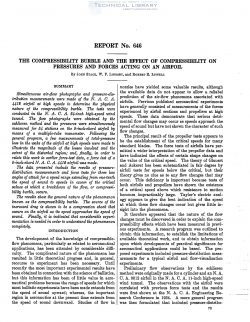naca-report-646

- Version
- 246 Downloads
- 1.87 MB File Size
- 1 File Count
- August 30, 2016 Create Date
- August 30, 2016 Last Updated
National Advisory Committee for Aeronautics, Report - The Compressibility Burble and the Effect of Compressibility on Pressure and Forces Acting on an Airfoil

Simultaneous air-flow photographs and pressure-dis-
tribution measurements were made of the N. A. C. A.
4412 airfoil at high speeds to determine the physical
nature of the compressibility burble. The tests were
conducted in the N. A. C. A. 24-inch highrspeed wind
tunnel. The flow photographs were obtained by the
schlie-ren method and the pressures were simultaneously
measured for 54 stations on the 5-inchrchord airfoil by
means of a multiple-tube manometer. Following the
general program, a few measurements of total-pressure
loss in. the wake of the ain‘oil at high speeds were made to
illustrate the magnitude of the losses involved and the
extent of the disturbed region; and, finally, in order to
relate this work to earlier force—test data, a force test of a
5-inchwhord N. A. C. A. 441.9 airfoil was made.
The data presented include the results of pressure-
distribution measurements and force tests for three low
angles of attack for a speed range extending from one-tenth
the speed of sound to speeds in excess of the critical
values at which a breakdown of the flow, or compressi-
bility Imrble, occurs.
The results show the general nature of the phenomenon
known as the compressibility burble. The source of the
increased drag is shown to be a compression shock that
occurs on the airfoil as its speed approaches the speed of
sound. Finally, it is indicated that considerable experi—
mentation is needed in order to understand the phenomenon
completely.
The development of the knowledge of compressible—
flow phenomena, particularly as related to aeronautical
applications, has been attended by considerable diffi—
culty. The complicated nature of the phenomena has
resulted in little theoretical progress and, in general,
recourse to experiment has been necessary. Until
recently the most important experimental results have
been obtained in connection with the science of ballistics,
but this information has been of little value in acro-
nautical problems because the range of speeds for which
most ballistic experiments have been made extends from
the speed of sound upward; Whereas, the important
region in aeronautics at the present time extends from
the speed of sound downward.
| File | Action |
|---|---|
| naca-report-646 The Compressibility Burble and the Effect of Compressibility on Pressure and Forces Acting on an Airfoil.pdf | Download |

Comment On This Post